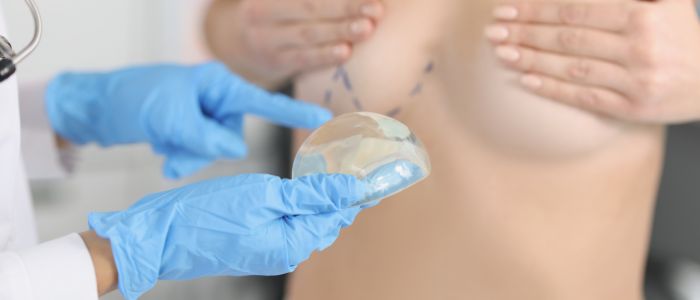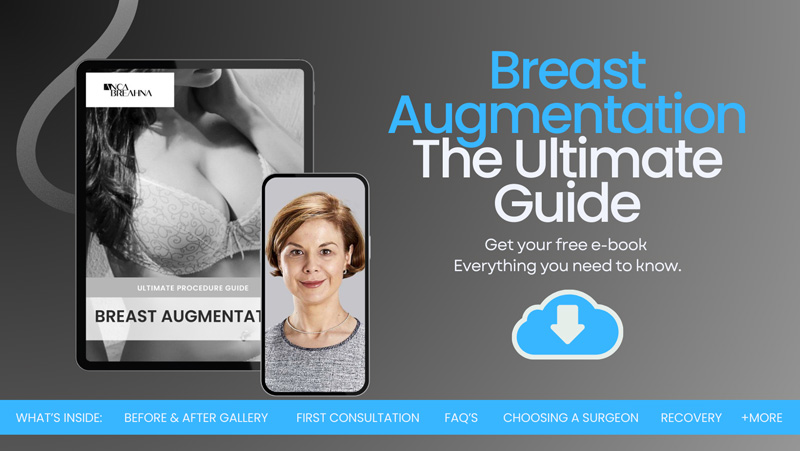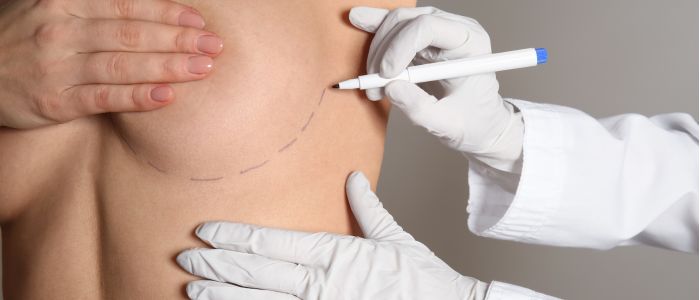
- Breast Implant Placement – Under the Muscle, Over the Muscle or Dual Plane
- Take our Plastic Surgery Quiz to find out if you'd be a good candidate for cosmetic surgery.
- Why Is Implant Placement Important?
- Different Types of Breast Implant Placement
- Download Miss Anca Breahna Breast Augmentation Guide
- Submuscular Breast Implant Placement
- The Advantages of Under-the-Muscle Breast Implant Placement
- Considerations for Submuscular Breast Implants
- Comparing Subglandular and Submuscular Breast Implants
- Dual Plane Breast Implant Placement
- Breast Augmentation Before and After Photos
- How to Choose the Right Breast Implant Placement for You
- FAQs about Breast Implant Placement
- How long is the recovery period after breast implant surgery?
- Will the scars from the surgery be noticeable?
- Can I choose between saline and silicone implants regardless of the placement?
- How will I know if my implant has ruptured?
- Does implant placement affect the risk of developing breast implant illness (BII)?
- Will I need additional surgeries in the future related to my implant placement?
- How soon after childbirth or breastfeeding can I consider breast implant surgery?
- Further Reading about Breast Surgery with Consultant Plastic Surgeon Anca Breahna
- Medical References about Breast Implant Placement
Breast Implant Placement – Under the Muscle, Over the Muscle or Dual Plane
Breast implant placement, a crucial aspect of breast augmentation surgery, involves positioning the implant either underneath the pectoral muscle (submuscular) or directly behind the breast tissue, over the pectoral muscle (subglandular). The choice between these two options varies depending on several factors, including your body type, desired aesthetic outcome, and advice from your plastic surgeon.
In-depth knowledge about implant placement can significantly contribute to a successful operation and satisfying results. It’s not just about increasing the size of your breasts; it’s about enhancing your body proportion and achieving a natural look that suits you. The final decision on breast implant placement should always be a collaborative effort between you and your plastic surgeon, considering your individual needs and goals.
Breast implant placement can greatly influence both the appearance and feel of your breasts post-surgery. Understanding the differences and potential outcomes between subglandular and submuscular placement can assist you in making an informed decision.
Anca Breahna is a renowned plastic surgeon based in Chester, UK, specialising in breast surgery. She offers a range of breast surgery procedures including breast augmentation, breast reduction, and breast reconstruction, among others.
Take our Plastic Surgery Quiz to find out if you’d be a good candidate for cosmetic surgery.
Why Is Implant Placement Important?
Breast implant placement plays a significant role in determining how your augmented breasts will look and feel. It’s a critical factor that impacts the surgical results, including the shape, projection, and overall aesthetic appeal of your breasts. But it’s not just about the aesthetics. The placement of your implant can also influence the risk of complications post-operation, such as capsular contracture – a condition where the scar tissue around the implant hardens, causing discomfort and altering the shape of the breast.
Moreover, implant placement can affect the ease of mammography and breast self-examinations. It’s a decision that requires careful thought and understanding. The right placement can enhance your satisfaction with the surgery and contribute to a more positive body image.
Deciding on the correct placement for you isn’t a decision to rush into. It’s a choice that should be made with your plastic surgeon’s expert guidance, considering your lifestyle, medical history, and personal preferences.
Different Types of Breast Implant Placement
There are essentially two types of breast implant placement – subglandular and submuscular. Subglandular, or “over the muscle” placement, involves positioning the implant between your breast tissue and the pectoral muscle. This placement can provide a more rounded look and may be ideal for individuals with sufficient natural breast tissue.
Submuscular, or “under the muscle” placement, on the other hand, involves positioning the implant beneath the pectoralis major muscle. This placement can lead to a more natural look and feel, especially for individuals with little natural breast tissue.
A third type of breast implant placement is called “dual plane”. In this case, the implants are covered by the pectoral muscle on the upper part and the glandular tissue on the lower part.
Each type of placement has its advantages and potential drawbacks. Anca Breahna will discuss these with you during your consultation, taking into account factors like your anatomy, the size and type of implants you choose, and your desired outcome. It’s crucial to communicate openly with your plastic surgeon to ensure your expectations align with the potential results.
Download Miss Anca Breahna Breast Augmentation Guide

Submuscular Breast Implant Placement
Submuscular breast implant placement has gained popularity over the years due to its potential benefits. This procedure involves placing the implant partially or fully under the pectoral muscles, providing additional coverage and support for the implant. It may be an ideal choice if you have thin skin or little natural breast tissue.
By placing the implant under the muscle, Anca can create a more natural slope to the upper part of the breast. This placement can also reduce the visibility and palpability of the implant, leading to a more natural feel. It’s a technique that can deliver a subtle enhancement, perfect for those seeking a more understated look.
However, it’s worth noting that submuscular placement may involve a slightly longer recovery period due to the additional manipulation of the muscle tissue. You might experience more post-operative discomfort compared to subglandular placement. Your plastic surgeon will guide you through the recovery process, providing advice on pain management and activities to avoid.
The Advantages of Under-the-Muscle Breast Implant Placement
The submuscular method of breast implant placement offers several advantages. One of these is a reduced risk of capsular contracture, a common complication associated with breast implants. By placing the implant beneath the muscle, there is less chance of scar tissue forming and hardening around the implant.
Another significant advantage is the improved imaging during mammography. The placement under the muscle allows for better visibility of the breast tissue during a mammogram, ensuring any possible anomalies can be detected early.
Additionally, the under-the-muscle placement may lead to more natural-looking results, especially for those with thinner skin or less breast tissue. The muscle layer provides additional padding, reducing the likelihood of implant edges being visible or palpable, leading to a smoother, more natural contour.
Considerations for Submuscular Breast Implants
While submuscular breast implant placement has its advantages, it’s also essential to consider potential drawbacks. The procedure may be slightly more complex and potentially result in a longer recovery period, as the surgeon needs to manipulate the chest muscles during surgery. This could lead to more post-operative discomfort and a longer healing process.
Another consideration is the possibility of implant movement during chest muscle contractions. When you engage your pectoral muscles, particularly during exercise, there’s a chance that your implants may move or rotate, which could be a concern if you’re an athlete or regularly engaged in vigorous physical activity.
Lastly, while submuscular placement can offer more natural-looking results, the final outcome greatly depends on your individual anatomy and the skill of your plastic surgeon.
Comparing Subglandular and Submuscular Breast Implants
When comparing subglandular and submuscular placement, it’s important to consider your personal goals, lifestyle, and body type. Subglandular placement might be the better choice if you prefer a more pronounced upper breast fullness or if you engage in heavy chest workouts, as this placement avoids the potential movement of implants during muscle contraction.
On the other hand, submuscular placement might be more suitable if you have thin skin or little natural breast tissue, as the muscle provides additional coverage for the implant, potentially leading to more natural-looking results. It’s also a good choice if you’re concerned about potential complications like capsular contracture or if you want to ensure optimal imaging during mammograms.
In the end, the best choice depends on a thorough discussion with your plastic surgeon, who will recommend the most suitable option based on your individual needs and goals.
Dual Plane Breast Implant Placement
A relatively new approach to breast implant placement is the dual plane method. This innovative technique combines the benefits of both subglandular and submuscular placement. In a dual plane procedure, the implant is placed partially under the pectoral muscle and partially under the breast tissue.
This approach can offer the natural look of submuscular placement along with the fullness that subglandular placement provides. It’s particularly useful for patients with mild to moderate breast sagging, as it can provide a slight lift effect.
Breast Augmentation Before and After Photos
How to Choose the Right Breast Implant Placement for You
Choosing the right breast implant placement is a personal decision that should be made in consultation with a skilled and experienced plastic surgeon. It’s important to consider your body type, lifestyle, and aesthetic goals. Open and honest communication with your plastic surgeon about your expectations and concerns will help guide this decision.
Consider the pros and cons of each placement option, and don’t hesitate to ask questions or seek a second opinion if necessary.
FAQs about Breast Implant Placement
How long is the recovery period after breast implant surgery?
- The recovery period can vary depending on the individual and the type of placement chosen. Generally, most patients can return to light activities within a week. However, strenuous activities, especially those involving the upper body, should be avoided for at least 4-6 weeks. Anca will provide specific post-operative care instructions tailored to your situation.
Will the scars from the surgery be noticeable?
- Scarring is a natural part of the healing process. The visibility of scars depends on the incision technique used, individual healing factors, and post-operative care. Over time, most scars fade and become less noticeable. There are also treatments and topical products available that can help reduce the appearance of scars.
Can I choose between saline and silicone implants regardless of the placement?
- Yes, both saline and silicone implants can be placed either subglandularly (over the muscle) or submuscularly (under the muscle). The choice between saline and silicone is often based on personal preference, desired feel and appearance, and recommendations from the plastic surgeon.
How will I know if my implant has ruptured?
- Symptoms of an implant rupture can vary. For saline implants, a rupture is usually noticeable as the breast will deflate due to the saline solution being absorbed by the body. For silicone implants, ruptures might be less obvious and are sometimes called “silent ruptures.” Regular check-ups and imaging tests like MRIs can help detect ruptures in silicone implants.
Does implant placement affect the risk of developing breast implant illness (BII)?
- Breast Implant Illness (BII) refers to a range of symptoms some women attribute to their breast implants, though it’s not officially recognised as a medical diagnosis. Currently, there’s no conclusive evidence linking implant placement (subglandular or submuscular) to an increased risk of BII. It’s essential to discuss any health concerns with your plastic surgeon.
Will I need additional surgeries in the future related to my implant placement?
- While breast implants can last for many years, they are not considered lifetime devices. Over time, you might need additional surgeries due to reasons like implant rupture, capsular contracture, or cosmetic reasons. Regular follow-ups with your plastic surgeon can help assess the condition of your implants.
How soon after childbirth or breastfeeding can I consider breast implant surgery?
- It’s generally recommended to wait at least 6 months after childbirth or breastfeeding before undergoing breast implant surgery. This allows the breasts to return to their natural size and shape post-pregnancy and ensures that milk production has ceased.
Further Reading about Breast Surgery with Consultant Plastic Surgeon Anca Breahna
- Read more about Fat Transfer To Breasts / Lipofilling
- Read more about Mastopexy Augmentation (Uplift With Implants)
- Read more about How to Choose the Best Breast Implant Profile and Projection
- Read more about How to Fix Saggy Breasts – Breast Lift, Breast Implants or Both
- Read more about What are Pointy Breasts or Puffy Nipples?
- Read more about How to Choose the Best Implant Size
Medical References about Breast Implant Placement
- Placement of breast implants – Mayo Clinic
- Where will your breast implants be placed? – ASPS
- Breast Augmentation Procedure Steps – ASPS




 Ms Anca Breahna, PhD, MSc, FEBOPRAS, FRCS (Plast) is a highly regarded Consultant Plastic Surgeon specialising in the field of Aesthetic and Reconstructive Plastic Surgery. Anca performs a range of
Ms Anca Breahna, PhD, MSc, FEBOPRAS, FRCS (Plast) is a highly regarded Consultant Plastic Surgeon specialising in the field of Aesthetic and Reconstructive Plastic Surgery. Anca performs a range of 